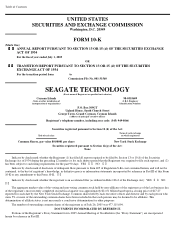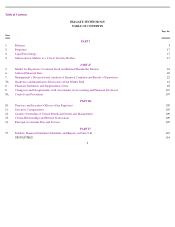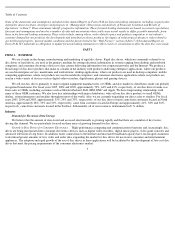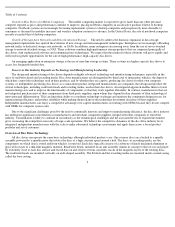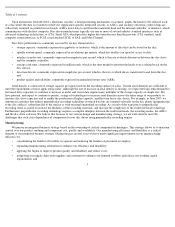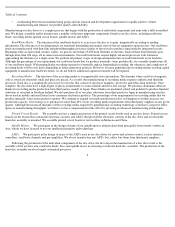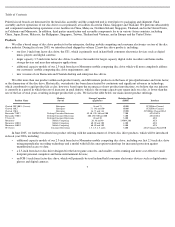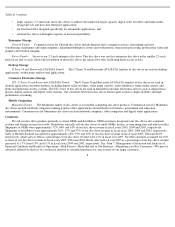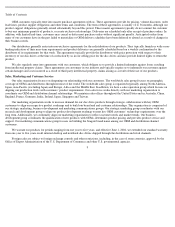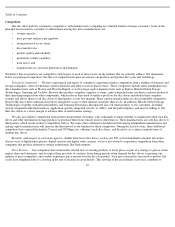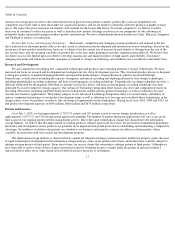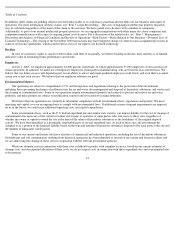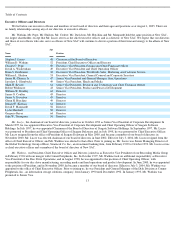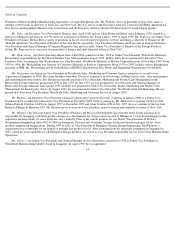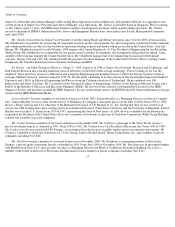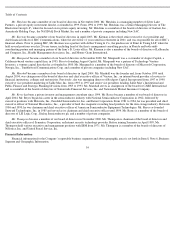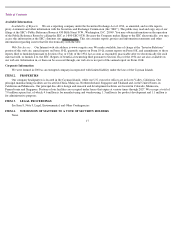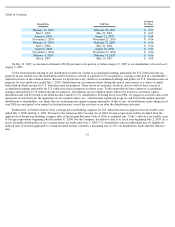Seagate 2004 Annual Report Download - page 12
Download and view the complete annual report
Please find page 12 of the 2004 Seagate annual report below. You can navigate through the pages in the report by either clicking on the pages listed below, or by using the keyword search tool below to find specific information within the annual report.
Table of Contents
Competition
The disc drive industry is intensely competitive, with manufacturers competing for a limited number of major customers. Some of the
principal factors used by customers to differentiate among disc drive manufacturers are:
•
storage capacity;
•
price per unit and price per gigabyte;
•
storage/retrieval access times;
•
data transfer rates;
•
product quality and reliability;
•
production volume capability;
•
form factor; and
We believe that our products are competitive with respect to each of these factors in the markets that we currently address. We summarize
below our principal competitors, the effect of competition on price erosion for our products and product life cycles and technology.
Principal Competitors . We have experienced and expect to continue to experience intense competition from a number of domestic and
foreign companies, some of which have greater financial and other resources than we have. These competitors include other independent disc
drive manufacturers such as Maxtor and Western Digital, as well as large captive manufacturers such as Fujitsu, Hitachi Global Storage
Technologies, Samsung and Toshiba. Because they produce complete computer systems, captive manufacturers can derive a greater portion of
their operating margins from other components, which reduces their need to realize a profit on the disc drives included in their computer
systems and allows them to sell disc drives to third parties at very low margins. Many captive manufacturers are also formidable competitors
because they have more substantial resources and greater access to their internal customers than we do. In addition, Hitachi Global Storage
Technologies (together with affiliated entities) and Samsung Electronics Incorporated also sell other products to our customers, including
critical components like flash memory, application-specific integrated circuits, or ASICs, and flat panel displays, and may be willing to sell
their disc drives at a lower margin to advance their overall business strategy.
We also face indirect competition from present and potential customers, who continually evaluate whether to manufacture their own disc
drives and other information storage products or purchase them from outside sources other than us. These manufacturers also sell disc drives to
third parties, which results in direct competition with us. We expect that continued consolidation both among independent manufacturers and
among captive manufacturers will increase the threat posed to our business by these competitors. During the last few years, three additional
competitors have entered the market; Cornice and GS Magicstor, offering 1-inch disc drives, and Excelstor as a contract manufacturer of
desktop disc drives.
Recently, with respect to our lower capacity, smaller form factor disc drives, such as our ST1 used in hand-held consumer electronics
devices such as digital music players, digital cameras and digital video cameras, we have also started to experience competition from other
companies that produce alternative storage technologies like flash memory.
Price Erosion . Our competitors have historically offered new or existing products at lower prices as part of a strategy to gain or retain
market share and customers, and we expect these practices to continue. Even during periods when demand for disc drives is growing, our
industry is price competitive and vendors experience price erosion over the life of a product. Such price erosion has increased as product life
cycles have lengthened due to a slowing in the rate of increase in areal density. This slowing of the areal density curve may contribute to
10
•
responsiveness to customer preferences and demands.


